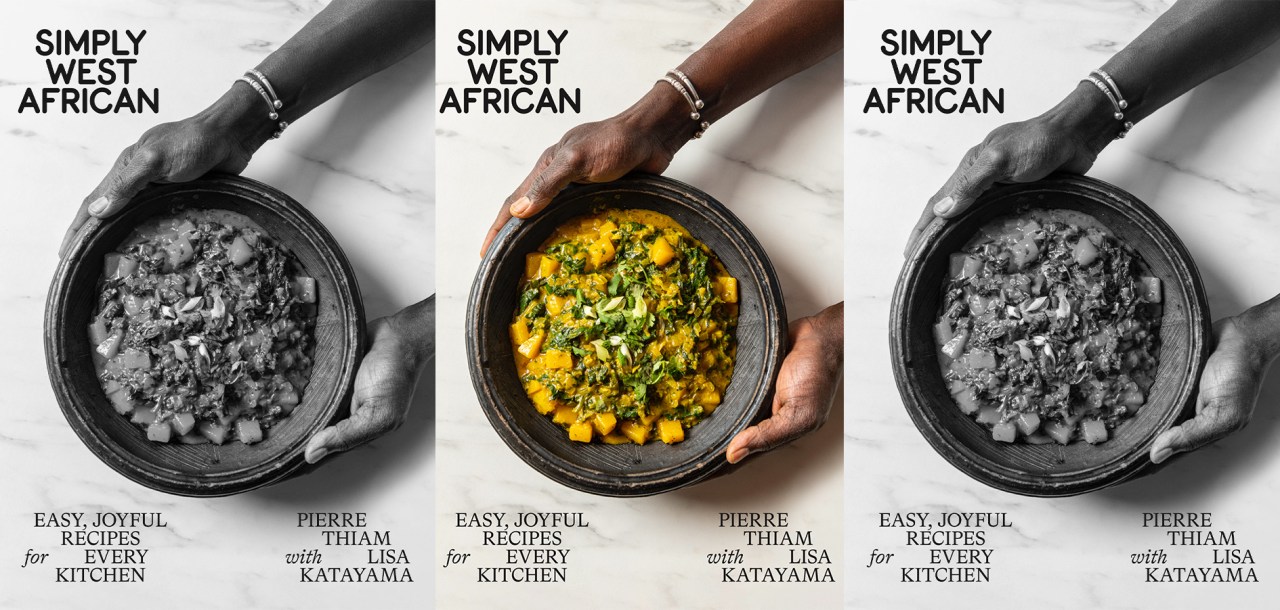Maya Angelou once wrote: “People will forget what you said, people will forget what you did but people will never forget how you made them feel.” Simply West African by the Senegalese-born, California-based chef and social entrepreneur Pierre Thiam is full of food that makes me feel welcome, loved and at home. Which is entirely appropriate because the Senegalese have a Wolof language word, “teranga”, which (while often mistranslated into English as “hospitality”) denotes a spiritual and philosophical worldview within which respectful, generous, welcoming behaviour is essential for the realisation of full personhood.
Pierre Thiam. (Photos: Evan Sung)
Joyful generosity is infused into every recipe in Simply West African. Thiam has previously published two Senegal-specific books; Yolele! Recipes from the Heart of Senegal (2009) and Senegal: Modern Senegalese Recipes from the Source to the Bowl (which was nominated for Best International Cookbook at the 2016 James Beard Awards).
Seafood okra soupou kanja, the ancestor of a New Orleans gumbo. (Photo: Evan Sung)
His third book, The Fonio Cookbook: An Ancient Grain Rediscovered (2019), focused on the drought-resilient, gluten-free, protein-rich millet species native to west Africa. Thiam’s business, Yolélé Foods, works with NGOs and smallholder producers to create an international market for this ancient grain. His fonio-focused Ted Talk has had more than one million views on YouTube.
With Simply West African he has broadened the focus, identifying culinary commonalities, clusters of ingredients, cooking techniques, flavour combinations, mouthfeels and attitudes towards hospitality that unite the regional west African eating experience. And what an experience it is.
Thiam has a fantastically flavoursome, amazingly biodiverse home base of indigenous ingredients with which to work. The opening section of the book deals with the pantry essentials necessary to create west Africa’s core tastes and textures. Readers are presented with a crash course on the plant-forward culinary culture within which meat and fish play a part but are often used sparingly – sometimes seasoning smoked or dried to heighten their pungent power.
Big Boss’s chicken, a.k.a. Poulet Directeur-Général. (Photo: Evan Sung)
The subtle sourness of attiéké (a.k.a. acheke, fermented cassava couscous) and the vast variety of perfumed spice pods and peppers are described in detail. As are the mouth-coating floral flavours of red palm fruit oil and the intense savoury splendour of fermented dawadawa beans – truly the ingredient that the word umami was waiting to describe.
Many cookbooks are prettier than they are useful. Not so with Simply West African. The pages are stylishly set out and the food photography is beautiful but not at the expense of clarity. There are helpful “how-to” sections on everything from the perfect way to peel black-eyed peas to checking that oil for frying cassava and plantain pof pofs is at the correct temperature.
Readers are guided, step by step, through methods for the region’s main “mother sauces”. Almost absurdly opulent mafé groundnut sauce and egusi seed paste bases compete for reader attention with the ruby-red verve of tomato, red pepper, ginger and chilli obe ata blends and the slow-cooked caramelised onion and lemon melange that makes up yassa sauce.
Charred sweet potatoes with rof sauce. (Photo: Evan Sung)
Once mastered, these mother sauces form the foundation for most of the subsequent recipes in the book including a Senegalese-style jollof rice, a coconut-rich Ghanaian waakye, and a peppery Nigerian buka soup full of black-eyed peas.
Thiam also offers an introduction to west African etiquette. He muses on the importance of teranga with its heartfelt desire for guests to never feel the “toumouranke” (disorientation is the closest English idea) of being a stranger.
Once basic recipes and manners have been mastered, Simply West African moves beyond culinary classics into modern reconfigurations of traditional tastes. Some recipes (such as Shrimp and Fonio Grits and Blackened Salmon with Moyo Sauce) bring west Africa and the west African diaspora in the Americas back together. Ndambe (black-eyed pea) nachos and Chicken Yassa Tacos serve up elements of Tex-Mex.
Shrimp and fonio grits. (Photo: Evan Sung)
Other recipes are Asian influenced. Thiam co-authored the book with his Japanese-born wife, Lisa Katayama, and her fantastic chicken suya (Hausa, northern Nigerian peanut, cayenne and ginger dry spice barbecue blend) recipe reimagined Tokyo yakitori style is a triumph of cross-cultural cuisine. As is the fonio porridge with grated ginger, smoked maceral fish and an umeboshi pickled plum garnish. There is also a rice ball recipe that combines elements of Japanese onigiri, Ghanaian omotuo and a mafé sauce.
Thiam’s toddler daughter, Naia, is not listed as a co-author on the cover, but her influence is felt throughout in the many child-friendly variations on west African eats. Such forays into fusion food run the risk of becoming inelegant confusion, but when they are done well, as they are here, the effects are exhilarating.
Senegalese bassi lamb stew. (Photo: Evan Sung)
Cooking from Simply West African reminded me of my initial encounters with the work of Yotam Ottolenghi. Obviously, Thiam is entirely his own man, but his work has a similarly bright, bold, easily accessible, plant-forward, seductive style. It introduces an audience to a region, a set of spices and a range of flavours that, before picking up the book, were almost unknown but once tasted are virtually impossible to live without.
As with Ottolenghi, every recipe is an opportunity to open universal conversations about good food, good living and the meaning of modernity. So, let’s. DM
Simply West African: Easy, Joyful Recipes for Every Kitchen; Pierre Thiam with Lisa Katayama. Potter books R600 on takealot.com
The author supports The Saartjie Baartman Centre for Women and Children in Manenberg. Their 24-hour crisis response service provides holistic social work support which includes housing and feeding up to 120 survivors of domestic violence daily. http://www.saartjiebaartmancentre.org.za
![]()
Source link








